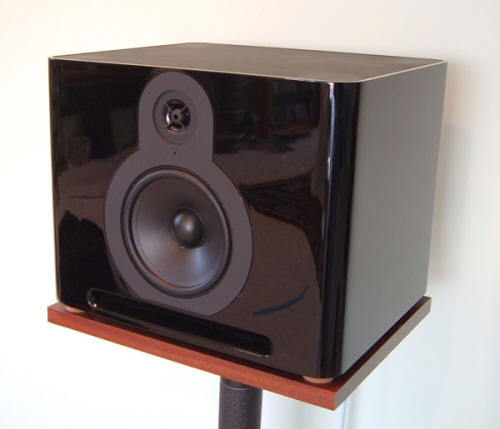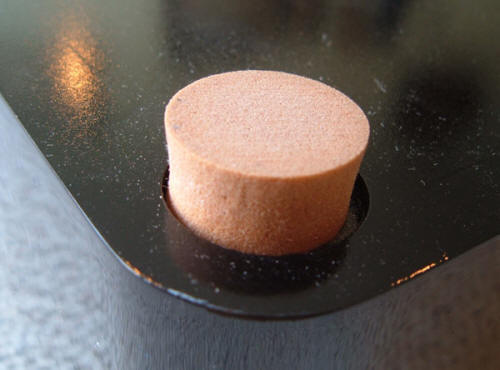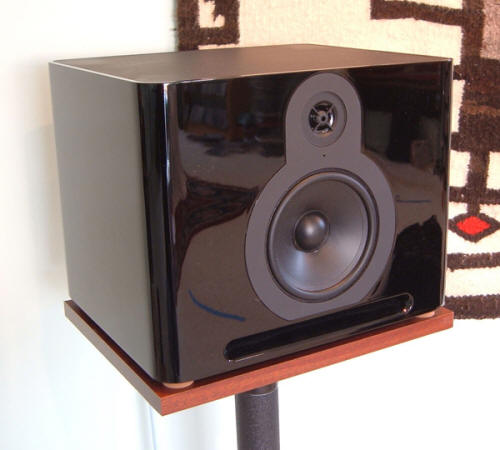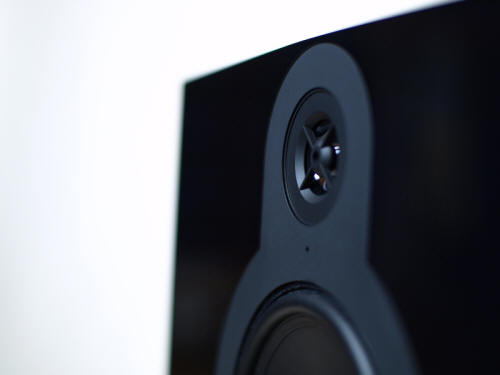
You are reading the older HTML site
Positive Feedback ISSUE
42march/april 2009
guru
QM10 monitor loudspeakers
as reviewed by Kent Johnson

|
KENT JOHNSON'S SYSTEM
LOUDSPEAKERS
ELECTRONICS
SOURCES
CABLES
ACCESSORIES SECOND SYSTEM
LOUDSPEAKERS
ELECTRONICS
SOURCE
CABLES
ACCESSORIES
|
I heard the GURUs for the first time at Rocky Mountain Audio Fest where I got to listen to Ingvar Öhman, their designer. He talked about the design of his speakers and what went into their manufacture. I also got to meet Lars Erickson, the managing director for Sjöfen HiFi at RMAF. Sjöfen is the North American importer of GURU Loudspeakers, SUPRA loud speaker cables, and several other brands, that for some reason, are not spelled in all capital letters. I had met Lars online last summer when I purchased some SUPRA speaker cables. Lars contacted me late in 2008 and asked me if I would like to review the GURU speakers for Positive Feedback Online.
The Swedish-made Guru QM10 loudspeaker is a small, two-way monitor loudspeaker. It measures only 12 inches wide by 10 inches deep, by 9.5 inches tall and weighs just 13 pounds. A single pair of European-style 4mm binding posts is located on the rear of the enclosure.
The drivers consist of a 16mm German-made tweeter and 102mm (four-inch) paper-coned midrange/woofer made by Tymphany of Denmark to GURU's specifications. These work in a vented 10-liter enclosure and are crossed over at 2,700 Hz. GURU claims a low-frequency response down to 30Hz. That's low for any speaker, much less one this small.
The GURU QM10 truly is a monitor loudspeaker with the QM referring to "Quality Manager." It has been used for years in recording studios. Since October of 2007, it has been manufactured for home use as well.
I had two concerns about reviewing the GURUs. The first regarded properly supporting them. Their footprint is twelve by ten inches; the stands I have do not have a top plate nearly this large. Lars assured me that, because of the SD (Sonic Design) insulators on the bottom of the speakers (they are cylindrical, stiff, and look like sponge rubber), the GURUs would be happy and uninfluenced by whatever supported them. They are, after all, made to sit on top of studio monitoring consoles.

The second concern involved amplification. GURU recommends using solid-state amplification with its speaker. As it happened, I was expecting a solid-state integrated amp sometime late in January, so I agreed to do this review assuming I would have that amp. As it happened, that amplifier never showed up but another integrated amplifier from Shengya Electronics did. So it worked out that I could audition these speakers with both tube and solid state amplification.
Set-up
I have some inexpensive 24-inch tall, sand-filled, metal speaker stands. I started looking for something that I could attach to their top plates that would expand their 6 by 6-inch area enough to adequately support the GURUs. I ended up buying a pre-finished, 10 by 36 inch, MDF shelf at Lowe's. I cut 12 inches off of each end of the shelf and attached these extensions to the tops of my stands. They fit the GURUs perfectly and have worked out very well. I discovered after doing this that dedicated stands made for the GURUs also use MDF top plates.
The GURUs are made to be positioned close to the wall and toed-in to the point where the outsides of each cabinet are just visible. I located the speakers about 9 feet apart in my main listening room. In this configuration, the speaker axes crossed just in front of my listening position, about 11 feet away.
I used my SUPRA 3.4/S Ply speaker cables for all my listening with the GURUs. According to Lars, Ingvar Öhman also did the theoretical work upon which the design of these cables is based. So, in theory, they should be ideal for use with the GURUs. In practice, they sounded extremely good; they are excellent cables.

I began listening using my normal system—Sony SACD player, Cullen DAC, Dodd preamp, Rogue 90 amp, and DH Labs Revelation interconnect cables.
Listening
I started serious listening with Yo-Yo Ma's Silk Road Journeys, When Strangers Meet (Sony SK 89782). Track 2 of this CD, "Byambasuren Sharav: Legend of Herlen," has soft delicate bell-like passages surrounding very loud and deep drum performances. Both were reproduced with impressive accuracy. The bells barely tinkled while the drum solos resonated throughout my entire listening space. Both decayed realistically into the overall sound stage. It was at the loudest point of a drum passage that I saw a quick blue flash from the right speaker. I was startled because I had completely forgotten about this aspect of the GURU's design.
The GURUs have blue leds in each speaker baffle located between the woofer and tweeter. These flash when the sound level is "beginning to approach a level of unacceptable distortion," to quote Lars. My overall listening level was modest—just loud enough to easily hear the delicate passages. The loudness was the result of the remarkable dynamic capabilities of these speakers.
This was the only time either led flashed despite doing all my listening at loudness levels that offered a realistic reproduction of the music.
Muddy Waters' Folk Singer (MFSL UDCD 593) has a soundstage that places Muddy in the middle with Willie Dixon's bass near and behind him. Buddy Guy's guitar resides in the right channel with Clifton James' drums in the left. The areas of the soundstage—left-center-right—offer no real sense of being part of a common space.
This was precisely how the GURUs reproduced the soundstage. What was impressive, however, was how much more detail I heard from this recording. Through the GURUs I could hear Muddy tapping his foot in time with the music; vocal subtleties (growls) that I had not been aware of, and other small details that improved the already excellent sense of being in the studio itself. I noticed this sort of subtle detail on other CDs as well. The GURU's monitor heritage subtly but recurrently revealed itself.

Diana Krall's Live in Paris (Verve 440 065 109-2) revealed the GURU's excellent midrange clarity and expressiveness. Her voice offered nuances of phrasing and inflection that conveyed a sense of being in the performing venue with her as well. The soundstage width was excellent, stretching speaker-to-speaker with well fleshed-out images. The audience applause was more immediate and filled the soundstage more completely than I have ever heard it before.
Xuefei Yang's CD, 40 Degrees North (EMI 50999 2 06322 2 9), features guitar music by both well known European composers—Albeniz, Tarrega, and Granados—as well as lesser-know contemporary Chinese composers. Her guitar filled the space between the speakers with a larger than life but very satisfyingly full sound. It is hard for someone like me to believe that there is only one guitar actually being played. The GURUs had no problem replicating the speed with which she is capable of producing notes.
With all of the recordings that I used to audition them, the GURUs offered a fairly large listening window as well. There was no appreciable change in the quality of the sound within reasonable amounts of side-to-side or up-and-down movement. The GURUs also created a very real sense of image height. Vocals floated above and completely free of the speakers.
Overall, the GURUs offer amazing bass, superb midrange, clear and clean treble, lots of realistic detail, and excellent soundstage width. The GURUs do soundstaging differently than other speakers. What I did not hear consistently was soundstage depth that extended beyond the plane of the speakers. The GURUs do soundstaging differently than other speakers.

In a speaker set up where the speakers are out in the room, away from the rear wall, the front of the soundstage is typically reproduced somewhere near the plane connecting the two speakers. This varies with both equipment and recordings but the soundstage usually starts from somewhere just in front of the speakers to just behind them. Soundstage depth is reproduced behind the speakers.
The GURUs, due to their near-wall positioning, project the soundstage forward. Diana Krall, for example, is recreated well in front of the plane that passes through the speakers themselves. There is no big difference between where Diana is located by the GURUs and a more conventional speaker set up. The difference is in the location of the performers behind her. With the GURUs, the soundstage rarely ever extended behind the plane of the speakers themselves, foreshortening the apparent depth on many recordings.
On some CDs, such as Folk Singer, the GURUs depth reproduction made no difference in the way the recording was reproduced. This also proved true on most of the orchestral CDs I listened to. With Silk Road Journeys, and most small to medium-sized ensemble recordings, though, there was a noticeable limit as to how far away the deepest part of the soundstage was allowed to extend.
During the time I was doing this listening, I did make some adjustments to the toe-in of the GURUs. I found that the soundstage width and, to a lesser extent, depth improved slightly by reducing the toe-in of the speakers. I ended up listening with the speakers aimed directly at my listening position. I could not see either side of the speaker enclosure. I felt that this improved the overall sound, at least within my listening room.
Jack Johnson's voice on In Between Dreams (Brushfire B0004149-02) had sounded somewhat aggressive in the original toe-in position. With the speakers directed right at me, this aggressiveness disappeared. The change in toe-in was slight but demonstrated that, while the GURU's design makes them relatively immune to their surroundings, experimenting with their set up can still offer some improvements in their performance (or at least cater to individual preferences).
The GURUs panels do exhibit a lot of vibration when the speaker is playing. Undoubtedly, they are contributing to the sound in the room. I was never able to clearly detect any effect on the overall sound from this contribution, however. Lars had recommended placing acoustic foam panels on the wall behind the GURUs to help damp out the first reflections coming from the walls. I do not have any acoustic panels but did experiment with pillows, rugs, and sofa cushions between and behind the speakers. Again, I did not hear any discernable affect with these items in place either. I am not convinced that I heard everything the GURUs had to give; I think there is still some performance to be had if a listener has more opportunity to try some room dampening materials with them.
Enter the Shengya
Lars Erickson had recommended that I use a high-quality solid-state amp with the GURUs. I thought the GURUs sounded extremely good driven by tubes but since I had the chance to listen with a second amplifier, I took advantage of it. The Shengya A-216 amplifier is a hybrid 150WPC integrated amp. It has a tube input stage combined with a solid-state output stage. In theory it offers some of the warmth of tubes with the control and lower output impedance of transistors ($1850).
Returning to Diana Krall, I noticed a slight improvement in soundstage depth, subtle changes in volume as her distance from the microphone varied, excellent bass, very fast drums, and cymbals that shimmered, along with a remarkably nuanced portrayal of her voice. But for the slight improvement in soundstage depth, I did not hear any great difference between the Shengya and my normal all-tube set up. Several recordings really stood out, though, when played through this Chinese/Swedish union. An older London CD of music by Warlock, Butterworth, and Britten by the Academy of St Martin-in-the-Fields proved absolutely captivating.
The three George Butterworth compositions, "A Shropshire Lad, Two English Idylls, and The Banks of Green Willow" were reproduced exceptionally well. They all exhibited remarkable delicacy and impressive dynamics. Solo instruments, especially the flute and oboe, sounded absolutely lifelike. Strings combined sweetness with a natural tartness. And orchestral crescendos had very satisfying loudness and weight. It was impossible to not be impressed with the GURUs remarkable ability to realistically reproduce the scale of this music from very soft to very loud. (London 421 391-2)
Elixir by Marilyn Mazur features her performing on a diverse collection of percussion instruments and related objects. Jan Garbarek accompanies her on several tracks playing various woodwinds. This recording has tremendous reverberations that cut across the soundstage and out into the room; the GURUs did an excellent job of reproducing them. There was a very tangible sense of where each sound began and how it extended out into the listening space.
The breathy quality of Garbarek's various instruments was clearly evident along with the halo of air surrounding them. I could also hear small sounds like the clicking of each instrument's keys. Overall, this is distinctive music that at its core provides a very satisfying emotional experience. My suspicion is that there is something innately human about wanting to hit things with a stick and see what sort of noise they make.
Cat Power's The Cover Record (Matador OLE 426-2) was absolutely lovely. Her voice is very arresting and I have to admit that I did not take enough notes to say anything more about this recording than that the GURUs exhibited all of its very special qualities. She is an artist well worth checking out if you are not already familiar with her work.
It seemed appropriate that I should end by mentioning one of the Swedish jazz CDs that I bought from Lars at Rocky Mountain Audio Fest. An Unplayed Venue by the Ludvig Berghe Trio, Vol III, is somewhat unconventional jazz played by a conventional piano, bass, and drum trio.
All the piano music I listened to with the GURUs struck me as very realistically reproduced. This was certainly the case here. Cymbals were very clean and acoustic bass exhibited good weight and definition as well. "Lament for an Unplayed Venue" utilizes bowed-bass, the lower notes of the piano, and cymbals to produce a dirge-like pace and gravity. This is offset by the right hand of the piano as it plays against this background. It is great stuff and the GURUs displayed the musical qualities of the performance to their best advantage.
Overall, both of the systems I listened to with the GURUs sounded extremely good and always musical.
Summary
I found the GURU QM10 speakers to be remarkable performers. They are truly full-range speakers in an incredibly small package. They image extremely well and have extraordinary dynamic range.
The only less-than-outstanding aspect of their performance that I noted was that soundstage depth was not as well produced as I have heard it on some recordings. How noticeable this was varied with the recording. Even when soundstage depth was noticeably diminished, it was certainly never absent.
When weighed against the GURU's strengths, this consideration proves to be extremely trivial. This is a speaker that you should definitely audition if you have the chance. You will be impressed. Kent Johnson
QM10 loudspeakers
Retail: $2695 for flat
black; $2995 for gloss black or white.
Size: 12 X 10 X 9.5 inches (WDH)
Weight: 13 pounds
Frequency response: 30-20,000 Hz ±1.5dB
Nominal impedance: 5 Ohms
Guru
web address:
http://www.sjofnhifi.com and
www.sonicdesign.se (Along with
information on damping materials, this website provides access to some
of Ingvar Öhman's papers on speaker design. Click on articles and
interviews near the bottom of the home page.)
